Atua narratives - key quotes from witnesses
Papatūānuku and Ranginui
- “Rangi embraced Papa and the world remained in darkness. Ka moetahi Ranginui raua ko Papatuanuku. One of their sons, Tane the ‘Atua’ of forests, separated Rangi and Papa to allow the light to penetrate the darkness and provide space for himself and brothers Tangaroa, Tawhirimatea, Rongomatane, Haumietiketike, Whiro and others who lived in the tight embrace of darkness. It is on the basis of this genealogy that all things of the world are related – the trees, the fish, the birds, the insects, the butterflies, stones, rocks, the small plants, turehu, the male elements and female elements of the heavens, those who live under the sea, and people. The excruciating pain from Papatuanuku was heard the moment light came into the world and is likened to the karanga of the women on their sacred whenua Papatuanuku. The separation caused Papatuanuku to bleed, and this bleeding created kokowai, the sacred ochre of Kurawaka … Tane took some earth from Papatuanuku, from Kurawaka, and kneaded, shaped and fashioned Hine Ahu One. He took aspects of his brothers who were tied into her human form and took her as his wife. This was the physical creation of the female element that originated in Papatuanuku. Of all that was created, people or tangata were the most important. Theirs was the highest degree of being, the highest form of tapu. When Hinetitama became an adult she was informed that Tane was her father she was so ashamed that she became Hinenuitepo the origin of death to mankind in this world.” (Hana Maxwell, doc A69, pp 1-2)(external link)
- “Ka po, ka ao, ka awatea, e ko Rangi o runga e ko Nuku ki raro. Na raua ka puta ko Tane, na Tane I wehe I a Rangi raua ko Papa. Na Tane I pokepokehia a Hine-Ahuone I te one I Kurawaka, na Hine-Aimone ko Hinetitma, nana ko Hine-nui-te-po. Tera ka puta te ira tangata ki te whai ao ki te ao marama. Tihei mauri ora.” (Te Motoi Taputu, doc A50, p 2)(external link)
“From darkness came night, there is Rangi above, there is Papatuanuku below. They gave birth to Tane, he separated Rangi and Papa, he fashioned Hineahuone from the sacred earth of Kurawaka. From Hineahuone comes Hinetitama, from her Hinenuitepo. This lineage gives rise to us, tangata whenua who still maintain presence here.” (Te Motoi Taputu, doc A50(a), p 2)(external link)
- “Te Po Kutikuti Kakarouiri was the darkness of intense romance. The night of love and romance. It is here where Ranginui copulated over the naked body of Papatuanuku. Many tipua ascended from her into the Pō. During this period many atua were conceived and born in Te Po Kakarouiri.” (Hira Huata, doc A149, pp 5-6)(external link)
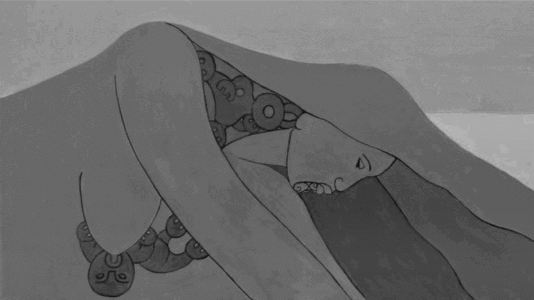
Papatūānuku me Rūāumoko (2019) by Robyn Kahukiwa (picture in document A30(c))
Papatūānuku
- “Papatuanuku – mother earth. She is the land on which we survive and, therefore, must be cared for by us to enable the continued existence of human life. It is our responsibility to care for and nurture Papatuanuku so that she in turn, will care for and nurture us. This is, and has been, the way since the beginning, and should be until the end of the existence of human life. To nurture and care for Papatuanuku means that we need to understand the environment that is around us, not just the house we live in. To care for that environment, is to care for Papatuanuku. Within the caring for the land, we care for each other, and for future generations.” (Patricia Tauroa, doc A60, pp 4-5)(external link)
- “For Māori our Atua whaea began with Papatuanuku. She is the ultimate role model for wāhine Māori. She portrays the nurturing aspects of a mother, and it is through the fruits of her labour that we exist.” (Awhirangi Lawrence, doc A58, p 3)(external link)
- “[Ūkaipo is] a beloved name for Papatūānuku that refers to the pre-dawn breastfeeding hours when a mother provides her baby physical, emotional, intellectual, and spiritual nourishment and sustenance through the milk. The use of the term speaks to the divinity of the earth and wāhine in their capacity to nurture and fulfil all the basic needs of humanity.” (Ngahuia Murphy, doc A67, p 3)(external link)
- “Māori have a lot of respect for Papatūānuku, the Earth Mother who is our nurturer. We were formed from her and when we die we return to her, embracing us in her loving care. She sustains us with all our cultural needs. Papatūānuku is our Atua Whaea from where our whakapapa starts from.” (Ngaronoa Kimura, doc A139, p 2)(external link)
- “Earth-Mother, foundation, creator and recreator of life and life-giving forces, platform for kai and rongoa seeds to grow in, nutrients to grow and return to their prior state as part of Papatuanuku; place for turangawaewae tapu, wahi tapu, whare tupuna, tupuna, tamariki, mokopuna to stand and live; connection / hononga whakapapa.” (Aorangi Kawiti, doc A24(a), p 5)(external link)
- “In the Māori world view, land gives birth to all things, including humankind, and provides the physical and spiritual basis for life. Papatūānuku, the land, is a powerful mother earth figure who gives many blessings to her children. She is a mother earth figure who gives birth to all things, including people. Trees, birds and people are born from the land, which then nourishes them.” (Te Ringahuia Hata, doc A30(b), p 3)(external link)
- “Ko Ranginui i tāpapa i waenganui o wō kuha, tā te karanga o whenua, ka rere a wai i roto ia kopu. Tuki ake, tuki atu, kua eke ake to wā. Ko koe tēnā Papatuanuku te whaea o ngā whāea.
He Atua!
He Tipua!
He Taniwha!
He Tangata!
Hō!” (Hera Black-Te Rangi and Mareta Taute, doc A116, p 8)(external link)
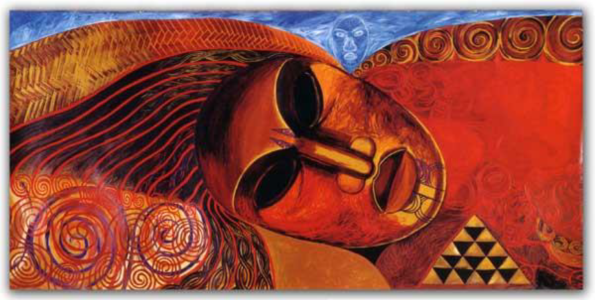
Papatuanuku E Takoto Nei by Robyn Kahukiwa (pictured in document A30(c))
Wainuiātea
- “Wainuiātea was the first wife of Rangi-a-watea which is the ancient name for Ranginui. They had all female children, creating the cosmos and the waters. She was unable to give Rangi-a-watea sons so asked her daughter Hinemoana to part her waters to unveil Papatūānuku. As reluctant as Hinemoana was she agreed to her mother’s request. As foreseen by Wainuiātea, Rangi-a-watea gazed upon the beauty of Papatūānuku. When Rangi-a-watea left Wainuiātea he took on the identity of Rangi.” (Paula Ormsby, doc A55, p 7)(external link)
- “Wainui Atea and Ranginui consummated their love and produced 72 atua wāhine. After that, Papatuanuku and Ranginui consummated their relationship and produced 72 atua tane.” (Kayreen Tapuke, doc A94, p 9)(external link)
Hineahuone
- “Hineahuone fashioned from red clay by Tane breathes his life force into her causing her to sneeze – hence the saying Tihei Mauri Ora – behold the sneeze of life.” (Hilda Harawira-Halkyard, doc A79, p 3)(external link)
- “In Te Ao Māori, [Hineahuone] is the first human female form created so that there could be new human life born into this world, thereby, establishing the existence of male and female, and the ability to create human life through their relationship with each other – the union which ensures the creation of human beings.” (Patricia Tauroa, doc A60, p 5)(external link)
- “According to Māori historical narratives, Hine Ahu One (earth-formed woman) was the first mortal woman. She was moulded by Tane, from different elements and parts of his mother Papatūānuku with help from his brothers. Red ochre clay and soil taken from the sacred lands of Kurawaka. As Tane breathed life into her physically and spiritually chanting ‘Tihei Mauri Ora’ – a common term used to open a whaikōrero in acknowledgement of the first breath that created humankind.” (Te Ringahuia Hata, doc A30(b), p 4)(external link)
- “Ko Io Matua i kōwhiria a Tāne ngā kete wānanga kia whiwhia kia rawea kia oi! Tū Te Mauri a Tāne Mahuta, Tāne Matua, Tāne Te Waiora, Tāne Te Hauora, Tāne Torokaha, Tāne Uehā, Tāne Te Wānanga, Tāne Whakahapū, Tānenuiārangi. Nāhana a Tāne i ahuahu mai i a Hine mai Te One o Kurawaka koia ko Hine-ahu-one te ahuahu o te kōiwi, te ūpoko, te tinana, ngā ringa ringa, ngā waewae, te tuara, te aroaro, ngā kikokiko, ngā uaua, ngā toto, te hinu. Ko te manawa ora ko ngā pukapuka, ko ngā takihi, ko te ate. Ko Maru apa i Te Ihonga nō Te Ihorangi te waiora, te waiaroha, te waimāori ki roto i a Hineahuone. Toroa atu a Tiki-āhua, a Tiki-nui, a Tiki-roa e Tāne te ihiihi, te ahuahu, kia toro te uaua, kia toro te akaaka nui, Te Akaaka Taikaha a Tiki e Tānematua. I ahuahua e Karihi ka hahana te puapua, Ka hahana te werewere, ka hahana te katitohe. Ka hahana a Mauhī a Maunene i Te Whare Tangata o Hineahuone. He tapu te whakairangatangata. ‘Kei reira te uha e puhi ana, e tuku ana, he tapu hoki te uha he iho tangata hoki’.” (Hira Huata, doc A149, p 14)(external link)
"Io Matua chose Tāne to acquire the baskets of knowledge to grow and be abundant! The life principle of Tāne Mahuta, Tāne Matua, Tāne Te Waiora, Tāne Te Hauora Tāne Torokaha, Tāne Uehā, Tāne Te Wānanga, Tāne Whakahapū, Tānenuiarangi. It was Tāne who shaped the first woman called Hine-ahu-one with the earth at Kurawaka. He shaped her skeleton, head, torso, arms, feet, back, face, flesh, sinew, blood, fat, heart, lungs, kidneys, and liver. Te Ihorangi implanted the eternal, compassionate and natural fluids into Hineahuone. Tāne then shaped Tikiāhua, Tiki-nui, Tiki-roa, implanting the essential forces and the sinew until Te Akaaka Taikaha a Tiki was created. Karihi shaped the ovaries, labia minora and vulva which emitted heat. And then the vagina emitted heat in Te Whare Tangata o Hineahuone. Conception is sacred. “That is where the femaleness resides, it is sacred and it is the essential quality of humankind”." (Hira Huata, doc A149(a), p 8)(external link)
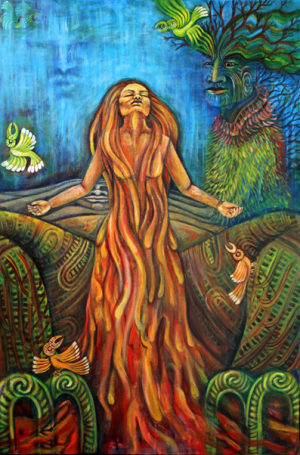
Hineahuone at Kurawaka by R Balzer (2014) (pictured in document A67(e))
Hinetītama and Hinenuitepō
- “Hinetītama is the mātāmua of the line of human beings; the tuākana of all Wāhine.” (Paula Ormsby, doc A55, p 8)(external link)
- “Hinetītama is the dawn maiden and personification of the setting sun. As she grew into a wahine, Tāne Mahuta decided to disguise his true identity and change himself into the form of a Man. Hinetītama fell in love and they had two daughters. Hinetītama become curious of her father and after inquiring discovered that her husband was also her father. Hinetītama upon her discovery decided to leave. She made her way to Rarohenga where she convinced Te Kūwatawata guardian of the entrance to let her in. As much as Tane tried to convince her to return to him, her decision was made, and she could not be swayed otherwise. Her daughters are Tahukumea and Tahuwhakairo who are the keepers of the gates of the underworld. Hinetītama took on her new identity as Hine-nui-te-po and her new status as goddess of death and the protector of life.” (Paula Ormsby, doc A55, p 8)(external link)
- “Tāne would later take Hine-titama for his wife and together they would parent many daughters. After some time passing, Hine-titama would question Tāne – who is my father? To which he replied, ‘Put your questions to the posts of the house’. It was soon revealed that Tāne, her husband, was also her father. With great shame and anger, Hine-titama chose to leave the world of light. And as she fled, she told Tane not to follow her – that she would go ahead to the dark world and prepare a place for their children in the afterlife. She would change her name to Hine Nui te Po (Great woman of the Night / Goddess of Death).” (Hinerangi Cooper-Puru, doc A27, p 4)(external link)
- “Hine Titama’s reaction typifies the rage against incest and personal shame, when she realises her beau Tane is her father, she flees to the underworld, changes her identity to become the goddess of death. She has no children. I wonder why Tane did not create another woman, why defile his daughter?” (Hilda Halkyard-Harawira, A79, p 4)(external link)
- “From Tānemahuta and Hineahuone came Hinetītama – born as the first of their children. Tānemahuta being an Atua she grew up not knowing who her father was. He however came to admire her and took her to be his first wife. Knowing he was an atua she asked him who her father was? He replied “Uia ngā pou o te whare” – telling her to ask the pillars of the house of Hui-te-ana-nui, a house built by Tāne himself. She realised that he was her father. In her shame she cast spells, left, and severed her connection with the world. Hinetītama then becomes Hinenuitepō; the goddess of the night and the overlord in the underworlds of Rarohenga. In quest of everlasting life (immortality), it is said that Mauī tried to conquer death by passing through Hinenuitepō. When he however entered her vagina, the fantail squeaked awaking Hinenuitepō from her slumber. Other tribes such as Tūhoe would have that they spoke to one another, Mauī requesting to live like [the] moon, to have phases, to become full and become empty again – but always present. Hinenuitepō declined, saying that we should live and die, to experience matemateāone, to know mortality. To Hinenuitepō then we credit the gift of death.” (Te Rua Wallace, doc A151, p 3)(external link)
- “Hine Nui Te Po, she who waits in the shadows to Rorohenga to welcome us home. Not the one to be feared as she is often portrayed, but the loving mother with open arms. She gives us a knowing that death is part of the journey and that we will never be alone. The guardian to the entranceway, the protector of those present and past, she who lights the spiritual fires to protect the people.” (Deirdre Nehua, doc A25, p 4)(external link)
- “Hinetītama was our very first wāhine. Our very first creation in the human form and so from her comes our whakapapa. When she became Hine-nui-te-pō, she took her negative experiences and turned it into a good thing. Instead of being cruel she became the night and went into the darkness to wait for her children.” (Robyn York, doc A65, p 3)(external link)
- “The pūrakau of Maui seeking immortality for humankind is one that speaks volumes to the strengths of Hine-nui-te-pō (the ancestress of death) and the power that is held within te whare tangata. Maui sought to achieve immortality by defeating Hine-nui-te-pō, as he had defeated the sun, the land and other powerful atua. Despite his father’s best efforts to dissuade him from this journey Maui relented and set out with his bird friends, including the tiwaiwaka. Maui proclaimed to his friends that he would climb through te whare tangata o Hine-nui-te-pō and out through her mouth. He insisted his friends make no noise as it could awaken Hine-nui-te-pō, and he would certainly meet his death. Maui undaunted entered te whare tangata o Hine-nui-te-pō, but his friend the tiwaiwaka bursted out in laughter awakening her. In anger she clapped her legs together and Maui was cut into two. Maui was the first to die in this way and because of his failure to defeat Hine-nui-te-pō all human beings became mortal. Hine-nui-te-pō remains the maiden goddess and portal to the underworld through which all humans must travel.” (Sandra Corbett, doc A45, pp 3-4)(external link)
- "Ko ngā mana kura o te ao wahine Māori, he mana toitū. Toitū te tangata, toitū te whenua, toitū te ao. He toitū ano te ara tāheke-roa ki te pō e. Kia takoto mai te rehunga tangata i roto i ngā ringa kaha o Hinenuitepō. Hoki ai te kikokiko ki a Papatuanuku, ko ngā wairua ki a Hinenuitepō, koia te kaiwehewehe i ngā wairua kia hoki atu ki ngā aorangi, ā, tae noa atu ki te okiokinga wairua, oti atu ai rātau.” (Sharon and Dr Mania Campbell, doc A39, p 7)(external link)
“The mana belonging to the universe of Māori women, is a mana that is persistent and permanent. The people persist, so does the land, and the universe. So does the long path to darkness. To lay in the hands of Hinenuitepō or death maiden. Ones flesh returns to Papatuanuku or earth mother, the spirits return to the death maiden, she sends the spirits to the skies, to the final resting place of the spirits, where they are gone for good.” (Sharon and Dr Mania Campbell, doc A39(a), p 7)(external link) - “Ka moe a Tāne i a Hinetītama, kātahi rawa ka whakarērea e Hinetītama a Tāne i tōna mōhio rawa, ko ia hoki tēnei ko tana pāpā. Ka whakarerea ki Rarohenga, na, ka huri ai ia ki te Atua kaitiaki rongonui i a tātou, ka noho a ia hei whaea mā mātou, ara ki te ira tangata. Ka mate ana te tangata, ko Hinenuiotepō tēnā kua karo nei i a mātou e whakawhiti atu ana i te mate ki te ora. Ko ia nei ko te tauira tuatahi o te mana nui ā te wahine, ki a tātou katoa e pae nei.” (Heeni Brown, doc A73, p 1)(external link)
Hine-Keira
- “Most people know of Tūmatauenga commonly referred to as the God of Man and War. … However, not many people know of Hine-Keira the goddess of war. Hine-Keira is his balance. She could destroy her opponent with her beauty, allowing her to get close enough to strike.” (Jessica Williams, doc A61, p 3)(external link)
Hine Akaaka
- “Hine Akaaka … is the atua of vines (akaaka) and is the balance to Tāwhirimātea.” (Jessica Williams, doc A61, p 4)(external link)
Hinewai and Hinetairi
- “The female Atua who control water and evaporation, Hinewai and Hinetairi, two of the numerous female Atua who make up the balance between the male and female Atua in their whakapapa.” (Donna Awatere-Huata, doc A20, p 9)(external link)
Hinemoana
- “Hinemoana herself is the ocean. She took three husbands. From the safe shoreline waters it is Kaukau, from where it’s no longer safe, from that point to the horizon, it is Tangaroa and, from the horizon thereafter is Te Moana Nui a Kiwa. Her whare lies on the horizon of the ocean where the water meets the sky.” (Paula Ormsby, doc A55, 8)(external link)
Hineteiwaiwa
- “Kia hoki anō ahau ki a Ranginui raūa ko Papatūānuku, ka puta ko Tāne, ka noho i a Hinetūiterepo, ka noho hoki i Hinerauamoa ka puta ko Hine te iwaiwa, te Atua tēnei o te harakeke, o te raranga, na, mō te whakawhānau tamariki hoki.” (Heeni Brown, doc A73, pp 8-9)(external link)
- “Hine-te-iwaiwa is the spiritual guardian of childbirth, weaving and the cycles of the moon. It is Hine-te-iwaiwa that assists at the entrance into, and the exits from this world.” (Paula Ormsby, doc A55, p 9)(external link)
- “Hine-te-iwaiwa, known as Hine, Sina or Ina in other parts of the Pacific, gave fish their special characteristics thus explaining the variety of marine life. In a version collected by southern historian James Herries Beattie, Hine-te-iwaiwa stomps the sole, tramples the sandfish and scratches the paikea, creating the distinctive markings on its front.” (Angela Wanhalla, doc A82, p 6)(external link)
- “The Atua Hinateiwaiwa has two roles, the house of birthing, and the essence of Te Whare Pora, a weaving house that embraces kairaranga, both conceptually and materially, providing the place of knowledge, and a place of practice.” (Aroha Louise Rickus, doc A140, p 3)(external link)
- “Hineteiwaiwa was associated not only with weaving, but also with pregnancy and birth, navigation, fishing and food cultivation, all guided by the phases of the marama, the moon. This suggests that wāhine as well as tāne had celestial knowledge, not just [of] the moon but also the stars. Many stars are thought to be female – e.g Matariki, Pohutukawa and Tipuānuku.” (Heeni Collins, doc A108, pp 13-14)(external link)
- “Hineteiwaiwa’s ability to formulate and execute complex and potentially dangerous strategy in order to achieve a desired goal reveals her as a woman with formidable political skill and significant leadership qualities. In the well-known story of Kae, who killed and ate Tinirau’s pet whale Tutunui, it is Hineteiwaiwa who takes responsibility for outwitting and capturing Kae … The parallel between what happened to Māui and the means by which Kae is identified before being conveyed by the women to a certain death is unlikely to be coincidental. As Māui presumptuously approached the vulva of his kuia, believing himself up to the task of unilaterally reversing the birth process, and as Kae feasted his eyes on the genitals of the women before him, each of the men was confronting his own mortality.” (Ani Mikaere, doc A17, pp 5-7)(external link)
Hineraukatamea
- “Te atua tonu o te ngahau” (Heeni Brown, doc A73, p 9)(external link)
Hineraukatauri
- “Te atua o te pūoro” (Heeni Brown, doc A73, p 9)(external link)
Hinetūiterepo
- Hinetūiterepo, te atua hoki tēnei o te raupō me te poi - kei roto hoki ai ia i te whare-tapere, te whare-karioi. (Heeni Brown, doc A73, p 10)(external link)
Mahora-nui-atea
- “Goddess of light Wife of Maku, she represents light in its first form before giving birth to Te Ra.” (Paula Ormsby, doc A55, p 9)(external link)
Murirangawhenua
- “Murirangawhenua, whose jawbone Maui used to both snare the sun and fish up Te Ika a Maui (the great fish of Maui).” (Lee Harris, doc A23, p 2)(external link)
- “Maui’s grandmother Muri-rangawhenua who gave him her jaw-bone ‘of enchantment and knowledge’ was known as one of the first wahine tohunga.” (Heeni Collins, doc A108, p 13)(external link)
- “Muri ranga whenua – the grandmother of Māui. Her jawbone gives an understanding of the upheavals that raised land above the seas. Without the jawbone of his grandmother, Māui would not have been able to perform the acts that he accomplished, including:
1. the fishing up of the lands to provide a place where human beings could live and survive; and
2. the slowing down of the sun to enable regularity in people’s daily lives.” (Patricia Tauroa, doc A60, p 6)(external link)
Mahuika
- “Atua of fire. Mahuika goddess and great grandmother of Māui.” (Paula Ormsby, doc A55, p 9)(external link)
- “Mahuika – who shows how fire is essential for human survival, as well as its potential for being destructive.” (Patricia Tauroa, doc A60, p 6)(external link)
- “Mahuika, who was the goddess / kaitiaki of fire. Maui tricked her into giving him all but one of her magical fire nails, the last of which she threw into the trees so that the gift of fire could live on in the world.” (Lee Harris, doc A23, p 2)(external link)
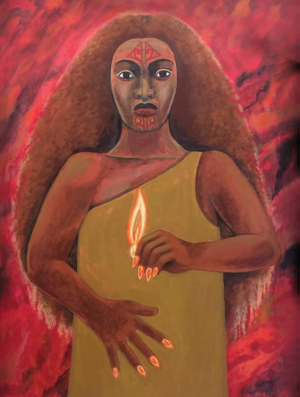
Mahuika by Robyn Kahukiwa, from front cover of Mana Wāhine Reader, volume 2 (pictured in document A148(c))
Tangotango
- “Tangotango, a celestial woman who fell in love with Tāwhaki and came to earth to become his wife. After bearing him a daughter, Arahuta, they argued and she returned to her natural realm.” (Paula Ormsby, doc A55, p 9)(external link)
Taranga
- “[Maui’s] mother whose magical topknot kept him alive.” (Lee Harris, doc A23, p 2)(external link)
Hinengakau
- “Hinengakau is another ira atua whose name has been immortalised through the whakataukī. ‘Te taura whiri a Hinengakau’. The encasement of the three siblings placed in the upper, middle, and lower Whanganui Awa. An important whakapapa that descends from Aotea. Hinengakau was known to be the peacemaker and her marriages strengthen the alliances between Tākitimu, Te Arawa, and Tainui.” (Whirimako Black, doc A84, p 4)(external link)
Irakau
- “In the Hauraki Gulf … Irakau is a female ancestor who had ‘mana over all the creatures in the ocean, including the whales and taniwha.” (Angela Wanhalla, doc A82, p 6)(external link)
Rongomaraeroa
- “Waitaha recognises Rongomaraeroa (Goddess of Peace), as being responsible for the matrilineal whakapapa of our Nation.” (Jane Ruka, doc A135, p 2)(external link)
Whakaari – He Maunga Tipua
- “Whakaari is our weathervane and beacon. She tells us the weather patterns, whether good or bad, when the best time is to go on the sea, and when to stay right away. … But more importantly, Whakaari is our ahi tipua, we are spiritually connected to her through whakapapa, and the sea scape that surrounds her, protects her, and calms her. The ocean bed cloaks Papamoana and moves in perfect motion with Hinemoana and they all communicate to each other … She isn’t a tīpuna whāea in the human sense, but she is our tipua whāea whom we draw strengths from as we do a wahine rangatira.” (Te Ringahuia Hata, doc A30(b), p 4)(external link)
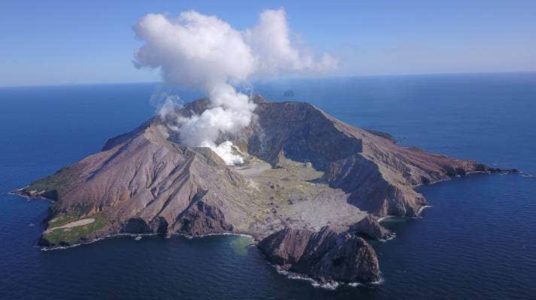
Whakaari (pictured in document A30(c))
Hinepūkohurangi
- “My Tūhoe whakapapa we descend from the goddess of mist Hinepūkohurangi who married Te Maunga (the mountain) and begat Pōtiki from whom Tūhoe is derived.” (Te Kahautu Maxwell, doc A46, p 3(external link); see also Jane Ruka and Te Miringa Huriwai, doc A53(a), p 4(external link); Te Rangitunoa Black, doc A99, pp 2-3(external link))
- “Ko Hinepūkohurangi te wahine, te tupuna, te atua o te kohu. Ka moe rāua ko Te Maunga. Kia mōhio mai he wahine Atua nō ngā rangi, ā, mai Hawaiki ki ētahi. Kei Ruatahuna tō rāua wāhi whakatakoto. Kei te puia harakeke tapu, kei muri he punua hiwi. I reira rāua e takoto ana me te mea nei kua huri kē rāua hei tangata o te whenua. I taea te takototahi. He nui tonu te tangata ka patai, ‘ka pēhea te takoto o Te Maunga me Hinepukohurangi? Ehara rāua mai Tūhoe. He tangata wehenga rua nga whakaaro ō ēnei tangata.’ Ko tētahi ko te moe o Hinepūkohurangi ki a Uenuku, te kopere. Heoi he kōrero tuku anō tēnei pūrakau, kōrero paki. He wahine Atua, he wahine mana. Koia nei te wahine māori, he ara uwha o Tahu. Ko te taha wahine o Tahu ko ngā mātua o Papatuanuku, nāna nei i timata tona tīmatatanga.” (Hera Black-Te Rangi and Mareta Taute, doc A116, pp 12-13(external link))
Te Marama / Rona
- “The moon is nearly always described as a female. There are a few times when the moon is said to portrays male behaviours, but this for the most part is uncommon. The names Marama, Maramahauakea, Hina, Hinapouri, Hinauri, Hinakeha, Māhina, Māhinarangi, Rona, Rongo and Hineteiwaiwa are at times used for the moon, and apart from Rongo, all of these names are female. They are also personifications of the various female deity who have a massive influence over the earth. The influence of this atua wahine should not be underestimated. She rules over all day-to-day activities and events of men and women. Māori understood that Tangaroa is the guardian of the ocean, but it is the moon that controls the tides – hence the proverb, Rona whakamau tai, Rona the controller of the tides. The impact of the moon further extended to all parts of the environment and on flora and fauna. Even the behaviours of people are influenced by the ever-changing cycle of the moon.” (Rangi Mātāmua, doc A86, p 9)(external link)
- “Ko Rona te whaea o te marama ā nōna te rangatiratanga o te tai ... Ahakoa i tauria a Rona ki Te Marama koia te mana o te wahine, kia aratākina ngā atua i ngā wahanga o ngā pō o ngā rā.” (Hira Huata, doc A149, p 7)(external link)
"Rona is the mother of the moon and controls the tides. The gods were aligned to the seasons of the year, to the weather patterns, to the moon, the night and the day." (Hira Huata, doc A149(a), p 3)(external link)
Hineraumati and Hinetakurua
- “The seasons themselves are ruled over by atua wahine. Māori have 2 main seasons, summer and winter. The Māori word for season is tau, and while we often apply that word in a modern context to denote year, its origin is season. The sun is said to have two wives, their names are Hineraumati (the summer maiden) and Hinetakurua (the winter maiden). These two beings are sisters and are the daughters of Tangaroa akiukiu. They give their names to the seasons that they represent, raumati means summer and takurua means winter. The sun is said to move between his two wives spending half the year with each. Hinetakurua lives far out in the ocean, and in the winter the sun rises in the nor’- east when Hinetakurua is seen in the morning sky. Hinetakurua is the star Sirius and the children of Hinetakurua and Te Ra are the different afflictions of winter including snow, hail and frost. Then in the summer the sun rises sou’- east and spend his days with Hineraumati. This atua wahine lives in the earth and her hair is said to be the tap roots of various root crops such as the kūmara. She provides water and nutrients and the sun gives light, and together they cause plants to grow. The children of Te Rā and Hineraumati are some summer phenomenon such as heat waves and even pollen. From this perspective the seasons occur because of the union between both male and female elements, with the sun being the central figure moving between his two wives. However, it is the atua wahine who rule over the actual seasons, determining the cold of winter and the heat of summer. Therefore, the Māori seasons are named after the atua wahine and not the sun.” (Rangi Mātāmua, doc A86, pp 4-5)(external link)
- Heoi anō kia hoki anō ki a Rangi rāua ko Papa, ka puta ko Tangaroa – nānā ko Hineraumati rāua ko Hinetakurua. Ko ēnei tonu ko ngā wāhanga e rua ā te Māori, ā, ka noho rāua i a Te Rā (o te whānau mārama), ko tāna he hoki atu he hoki mai ki a Hineraumati, ki a Hinetakurua noki. (Heeni Brown, doc A73, p 10)(external link)
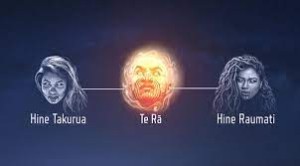
Hine Takurua and Hine Raumati (pictured in document A86)
Ngā Whetū
- “While there are variations in tribal records, my understanding is that the celestial objects are the children of Tangotango and Wainui. Tangotanga is male and is personified in the blackness that exists between the stars. Wainui is female and is embodied in all forms of water. Their children are Te Rā (the sun), Te Marama (the moon), Ngā Whetū (the stars), Hinātore (phosphorus light), Parikoikoi (gloomy light) and Hinerauāmoa (a small star). Collectively these beings are known as Te Whānau Mārama or the family of light, and all light in the universe emulates from these beings ... This genealogy clearly shows that the cosmos and all its objects is the result of a union between male and female elements, and a significant number of the Te Whānau Mārama are female, ie Wainui, Marama, Hinātore, Parikoikoi, Hinerauāmoa and many of the stars themselves.” (Rangi Mātāmua, doc A86, pp 3-4)(external link)
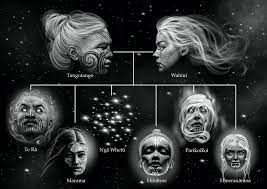
Te Whānau Marama (pictured in document A86)
- “Across Aotearoa, Māori tribes and communities celebrate the beginning of Te Mātahi o te tau, or the New Year, in conjunction with the heliacal appearance of certain stars, in particular Matariki and Puanga. Both of these stars appear in the pre-dawn sky around the same time during winter and different regions associate the visibility of these stars with the New Year. Both Matariki and Puanga are female stars, and they determine the bounty, productivity and major activities for the impending year … In my tribal narrative there are nine stars within the cluster of Matariki, while in other tribal versions there are seven – Matariki, Pōhutakawa, Tupuānuku, Tupuārangi, Waitī, Waitā, Waipunarangi, Ururangi, and Hiwaiterangi / Hiwa … All these stars surround their mother, the atua wahine that is Matariki. She is the central star that holds the entire cluster together, supports the wellbeing of the stars in the cluster and of people on earth.” (Rangi Mātāmua, doc A86, pp 6-8)(external link)
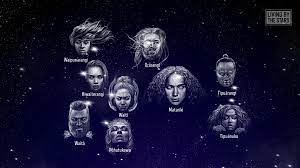
Ngā Whetū o Matariki (pictured in document A86)
- “The following is a small selection of atua wahine that are personified by stars. This list also includes the areas over which these stars hold dominion. The appearance of these stars and planets in particular parts of the sky during the year would determine the activity of the corresponding weather phenomenon, ecological event, or cultural and spiritual practice.” (Rangi Mātāmua, doc A86, p 10)(external link)
|
Whetū |
Star |
Domain |
|
Kōpū |
Venus |
Marker of the 5th month of the Māori year Sign of peace |
|
Pareārau |
Jupiter |
Sex |
|
Takero |
Mercury |
Migration and spawning of fish |
|
Pani Tīnaku |
Deneb |
Germination of plants |
|
Hinemataiti |
HR 8079 |
Kiore (rats) |
|
Takurua-whareana |
Murzin |
Snow |
|
Takurua-parawai |
Wezen |
Frost |
|
Takurua-āio |
o Canis Major |
Clam winter |
|
Ngā whata |
Alnilam |
Food storage |
|
Ruhi |
Alniyat |
Ripe food |